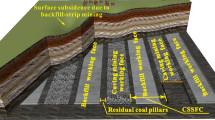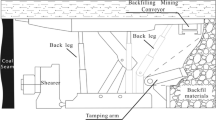Abstract
Because of the easily caused damage to ground buildings by shallow coal seam mining under the hard roof, backfill-strip mining has been gradually adopted to realize the sustainable development of mining and protection of ground buildings. The surface subsidence prediction method in backfill-strip mining is not clear enough to the shallow coal seam under the hard roof. This paper adopts the numerical simulation method to study the surface movement characteristics of shallow coal seam backfill-strip mining under the hard roof. The results show that the maximum surface subsidence and the stress of the filling body are directly proportional to the width of the caving mining working face in the range of 30 ~ 80 m. The stress of the coal pillars on both sides is unchanged. The thickness from the wave band to the surface conforms to the quadratic function. The characteristics of surface movement conform to the prediction model of the probability integral method. Based on the probability integral method, the superposition calculation method of backfill-strip mining is deduced, and the prediction parameters calculation equation of the whole backfill-strip mining area is given. Finally, 5 backfill-strip mining schemes are designed in combination with the case. According to the protection index and the economic benefits, the best mining scheme is determined. The research results provide a reference for surface subsidence prediction in similar geological conditions.












Similar content being viewed by others
Abbreviations
- W 0 :
-
The surface maximum subsidence value of full mining
- m :
-
The thickness of coal seam
- q :
-
Surface subsidence coefficient
- α :
-
Dip angle of coal seam
- r :
-
Major influence radius of the strike direction
- ρ :
-
The design filling rate of the working face
- a :
-
The width of the backfill working face
- b :
-
The width of the caving mining working face
- λ :
-
The recovery rate of the strip mining
- H :
-
The mining depth of coal seam
- tanβ :
-
The tangent of major influence angle
- b 0 :
-
The horizontal movement coefficient
- S :
-
The Inflection point offset
- θ 0 :
-
The propagation angle of extraction
References
China National Bureau of Coal Industry (2017) Rules for the mine extraction and coal pillars establishment under buildings, water bodies, railways and main laneways. China Coal Industry Press, Beijing (in Chinese)
Deng KZ, Tan ZX, Jiang Y et al (2014) Deformation monitoring and subsidence engineering. China University of Mining and Technology Press, Xuzhou (in Chinese)
Diao XP, Wu K, Chen RL et al (2019) Identifying the cause of abnormal building damage in mining subsidence areas using InSAR technology. IEEE Access 7:172296–172304
Dong Y, Huang YC, Zhao WP et al (2018) Research on safety of backfill mining strip pillars under villages. China Saf Sci J 28(08):117–122 (in Chinese)
Ghabraie B, Ren G, Barbato J et al (2017) A predictive methodology for multi-seam mining induced subsidence. Int J Rock Mech Min Sci 93:280–294
Goodarzi AR, Salimi M (2015) Stabilization treatment of a dispersive clayey soil using granulated blast furnace slag and basic oxygen furnace slag. Appl Clay Sci 108:61–69
Guo GL, Wang YH, Ma ZG (2004) A new method for ground subsidence control in coal mining. J China Univ Min Technol 33:150–153 (in Chinese)
Guo GL, Zhu XJ, Zha JF et al (2014) Subsidence prediction method based on equivalent mining height theory for solid backfilling mining. Trans Nonferrous Metals Soc China 24(10):3302–3308
Guo GL, Li HZ, Zha JF (2019) An approach to protect cultivated land from subsidence and mitigate contamination from colliery gangue heaps. Process Saf Environ Prot 124:336–344
Guo KK, Guo GL, Li HZ et al (2020) Strata movement and surface subsidence prediction model of deep backfilling mining. Energy Sources Part A: Recover Utili Environ Eff 2020:1–15
Guo GL, Li HZ, Zha JF et al (2023) Research status and countermeasures of coordinated development of coal mining and cultivated land protection in the plain coal-cropland over-lapped areas. Coal Sci Technol 51(01):416–426 (in Chinese)
He H, Dou LM, Fan J et al (2012) Deep-hole directional fracturing of thick hard roof for rockburst prevention. Tunn Undergr Space Technol 32:34–43
He J, Dou LM, Mu ZL et al (2016) Numerical simulation study on hard-thick roof inducing rock burst in coal mine. J Cent South Univ 23(9):2314–2320
Jahandari S, Tao Z, Saberian M et al (2022) Geotechnical properties of lime-geogrid improved clayey subgrade under various moisture conditions. Road Materials and Pavement Design 23(9): 2057–2075
Jiang Q, Guo GL, Li HZ et al (2022) Investigation of coordinated development of coal mining and pipeline protection under boundary effect of thick unconsolidated layer. Bull Eng Geol Env 81(4):1–12
Khajeh A, Jamshidi Chenari R, Payan M (2020) A simple review of cemented non-conventional materials: soil composites. Geotech Geol Eng 38(2):1019–1040
Khajeh A, Ebrahimi SA, MolaAbasi H, Jamshidi Chenari R, Payan M (2021) Effect of EPS beads in lightening a typical zeolite and cement-treated sand. Bull Eng Geol Env 80(11):8615–8632
Khajeh A, Jamshidi Chenari R, MolaAbasi H, Payan M (2022) An experimental investigation on geotechnical properties of a clayey soil stabilised with lime and zeolite in base and subbase courses. Road Mater Pavement Des 23(12):2924–2941
Khaksar Najafi E, Jamshidi Chenari R, Payan M, Arabani M (2021) A sustainable landfill liner material: clay-fly ash geopolymers. Bull Eng Geol Env 80(5):4111–4124
Khanal M, Hodgkinson JH (2021) Subsidence prediction versus observation in Australia: a short comment. Environ Impact Assess Rev 86:106479
Li HZ, Guo GL, Zhai SC (2016) Mining scheme design for super-high water backfill strip mining under buildings: a Chinese case study. Environ Earth Sci 75(12):1–12
Li HZ, Zha JF, Guo GL (2019) A new dynamic prediction method for surface subsidence based on numerical model parameter sensitivity. J Clean Prod 233:1418–1424
Li M, Zhang JX, Sun K et al (2019) Reducing surface subsidence risk using solid waste backfill technique: a case study under buildings. Polish Journal of Environmental Studies 28(5):3333–3341
Miao XX, Zhang JX, Guo GL (2010) Study on waste-filling method and technology in fully-mechanized coal mining. J China Coal Soc 35(01):1–6 (in Chinese)
Ngamkhanong C, Keawsawasvong S, Jearsiripongkul T, Cabangon LT, Payan M, Sangjinda K, ..., Thongchom C (2022) Data-driven prediction of stability of rock tunnel heading: an application of machine learning models. Infrastructures 7(11):148
Nie L, Zhang M, Jian HQ (2013) Analysis of surface subsidence mechanism and regularity under the influence of seism and fault. Nat Hazards 66(2):773–780
Saeidi A, Deck O, Verdel T (2012) Development of building vulnerability functions in subsidence regions from analytical methods. Geotechnique 62(2):107–120
Salmi EF, Nazem M, Karakus M (2017) Numerical analysis of a large landslide induced by coal mining subsidence. Eng Geol 217:141–152
Senol A (2012) Effect of fly ash and polypropylene fibres content on the soft soils. Bull Eng Geol Env 71(2):379–387
Shirmohammadi S, Ghaffarpour Jahromi S, Payan M, Senetakis K (2021) Effect of lime stabilization and partial clinoptilolite zeolite replacement on the behavior of a silt-sized low-plasticity soil subjected to freezing–thawing cycles. Coatings 11(8):994
Tan YL, Zhang Z, Zhao TB (2011) AE pattern of rock burst disaster induced by strata activation in coal mine. Disaster Adv 12(4):29–33
Venvik G, Bang-Kittilsen A, Boogaard FC (2020) Risk assessment for areas prone to flooding and subsidence: a case study from Bergen, Western Norway. Hydrol Res 51(2):322–338
Vusovic N, Vlahovic M, Krzanovic D (2021) Stochastic method for prediction of subsidence due to the underground coal mining integrated with GIS, a case study in Serbia. Environ Earth Sci 80(2):1–29
Wang ZS, Deng KZ (2012) Edge-amended model of probability-integral method for subsidence prediction. J Xian Univ Sci Technol 32(04):495–499 (in Chinese)
Wang QC, Guo GL (2020) Analysis of surface subsidence and deformation of thick mechanized coal gangue filling mining under village. Saf Coal Min 51(1):222–228 (in Chinese)
Wang F, Miao L (2009) A proposed lightweight fill for embankments using cement-treated Yangzi River sand and expanded polystyrene (EPS) beads. Bull Eng Geol Env 68(4):517–524
Wang L, Li N, Zhang XN (2015) Surface subsidence quantitative control method of shallow buried coal mining with strip mining solid backfilling. Saf Coal Min 46(11):31–34 (in Chinese)
Wang W, Cheng YP, Wang HF et al (2015b) Coupled disaster-causing mechanisms of strata pressure behavior and abnormal gas emissions in underground coal extraction. Environ Earth Sci 74(9):6717–6735
Wang H-S, Tang C-S, Gu K, Shi B, Inyang HI (2020) Mechanical behavior of fiber-reinforced, chemically stabilized dredged sludge. Bull Eng Geol Env 79(2):629–643
Wei T, Guo GL, Li HZ et al (2022) Fusing minimal unit probability integration method and optimized quantum annealing for spatial location of coal goafs. KSCE J Civ Eng 26(5):2381–2391
Xuan DY, Xu JL (2014) Grout injection into bed separation to control surface subsidence during longwall mining under villages: case study of Liudian coal mine, China. Nat Hazards 73(2):883–906
Yuan YF, Li HZ, Zhang HJ et al (2020) Improving reliability of prediction results of mine surface subsidence of Northern Pei County for reusing land resources. Appl Sci 10(23):8385
Zha JF, Guo GL, Feng WK et al (2011) Mining subsidence control by solid backfilling under buildings. Trans Nonferrous Metals Soc China 21:670–674
Zhang JX, Zhang Q, Sun Q et al (2015) Surface subsidence control theory and application to backfill coal mining technology. Environ Earth Sci 74(2):1439–1448
Zhang Q, Liu H, Zhai SC et al (2017) Design and effect evaluation of the filling strip mining scheme under buildings. Metal Mine 496(10):105–109 (in Chinese)
Zhou N, Liu HF, Zhang JX et al (2019) Study on rock burst event disaster and prevention mechanisms of hard roof. Adv Civ Eng 2019:1–14
Zhu XJ, Guo GL, Zha JF et al (2016) Surface dynamic subsidence prediction model of solid backfill mining. Environ Earth Sci 75(12):1–9
Zhu XJ, Guo GL, Liu HZ et al (2019a) Experimental research on strata movement characteristics of backfill–strip mining using similar material modeling. Bull Eng Geol Env 78(4):2151–2167
Zhu XJ, Guo GL, Liu HZ et al (2019b) Surface subsidence prediction method of backfill-strip mining in coal mining. Bull Eng Geol Env 78(8):6235–6248
Zhu XJ, Zha F, Guo GL et al (2021) Subsidence control design method and application to backfill-strip mining technology. Adv Civ Eng 2021:1–15
Funding
This work was funded by the Innovation and Demonstration Program of Geology & Mineral Resources of Shandong Province (Grant No. HJ202206) and the Major Innovation Program of Shandong Province (Grant No. 2022CXGC011403).
Author information
Authors and Affiliations
Corresponding author
Ethics declarations
Conflict of interest
The authors declare no competing interests.
Rights and permissions
Springer Nature or its licensor (e.g. a society or other partner) holds exclusive rights to this article under a publishing agreement with the author(s) or other rightsholder(s); author self-archiving of the accepted manuscript version of this article is solely governed by the terms of such publishing agreement and applicable law.
About this article
Cite this article
Bo, H., Guo, G., Li, H. et al. Study on surface subsidence prediction method of shallow coal seam backfill-strip mining under the hard roof. Bull Eng Geol Environ 82, 281 (2023). https://doi.org/10.1007/s10064-023-03284-3
Received:
Accepted:
Published:
DOI: https://doi.org/10.1007/s10064-023-03284-3




